PAGE 33 -JANUARY 2005
 Part 2: Small-Scale Bookshelves
Part 2: Small-Scale Bookshelves
Bookshelf layouts may provide the most railroad fun per square inch or centimeter.
Last month, we explored large-scale trains running on bookshelves; this month, we
present smaller-scale trains — 1:48 (narrow gauge) and smaller. As these are by far
the most popular sizes for home layouts, you may well find some inspiration here!
From Ian Holmes, a veteran modeler who lives in Princeton, Minnesota, comes this classic Inglenook switching layout in On30 scale. Marathon Seed and Feed measures 30″ x 8″ with a sector plate at the left hand end and a traverser at the right. Though he still has a lot of detailing to add, Ian’s work already looks pretty good!
Comments Ian: “It’s much like Cycles de Berlan and Boracho Brewery on your website. So far the outlay on the layout is $0.00 — all the track is reclaimed from a previous layout, and the buildings are all cardboard with bits of styrene here and there. Trees need to be changed to pine trees but that entails spending money … which isn’t in the brief (yet)!”
The track plan can be used as an Inglenook game, or — using the traverser — more complex operations can be undertaken. Rolling stock includes two critters from Bachmann — a Porter 0-4-0 steamer, and a Davenport IC lokey. In all, On30 scale puts a lot of railroading onto a relatively small bookshelf.
SCALE 1:76 (OO)
A Pair of Starter Shelves
Here are two simple shelf layouts, made from sectional track, that could be the basis for your first micro layout! Or, if you’re looking for some operating fun with just a little effort, even a seasoned model rail could enjoy these bookshelves. They’re built with 16.5mm gauge track, used in England for 1:76 OO scale trains and in the U.S. for 1:87 HO scale trains. Your choice!
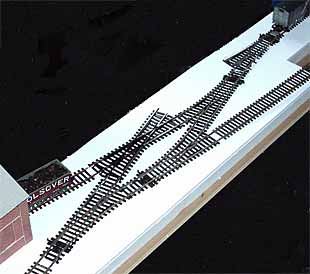 Woodside Wharf is a 48×8 inch bookshelf being built by John Downes who lives in Kent in England. The wharf is foamcore board, the trackwork is Peco, and all the locos and stock are Hornby and Dapol four-wheeled vehicles.
Woodside Wharf is a 48×8 inch bookshelf being built by John Downes who lives in Kent in England. The wharf is foamcore board, the trackwork is Peco, and all the locos and stock are Hornby and Dapol four-wheeled vehicles.
“Operation,” writes John, “will either be by shuffling and dealing cards to decide where each wagon should end up, or I may press a venerable Sinclair computer into service to randomly allocate each wagon to a siding.”
The photo at right shows the heart of the track plan, a complex of Peco points (turnouts) that create an interesting pattern that provides some shunting snags for switchmen!
Another simple track layout for a beginner’s shelf railroad is Pine Street Yard, being built by Ken Scott, from Sheffield, England. With a tip of the hat to Jack Trollope’s Box Street Yard, this four-foot bookshelf gets a lot of operation from just two turnouts — albeit one of them is a double-slip! The rear double tracks disappearing under the road overpass dead end into a fiddle yard, while the frontmost track continues in front of the backdrop as a private siding.
“I will be using the extra track as a ‘fiddle’ but pretend it ends under the bridge,” Ken says. “I have just bought an RDC railcar so I am planning a small station at the front right hand side. Beside the goods platform will be an oil depot and the spur to the right will probably be for coal or gravel.”
Though it’s still under construction, Ken reports this layout “runs a dream” and he’s already having a lot of fun switching (shunting) on it!
NOTE: Either of these two beginners’ layouts could also be used as an HO scale layout in the U.S. or continental Europe.
SCALE 1:76.2 (P4)
 Candy Mill is a 47×11 in bookshelf layout that illustrates the advantages of handlaying your own track! It’s under construction by Tony Maude, Pastor of the Peebles Baptist Church, Scotland. You can tell at a glance that it’s not made with standard sectional track!
Candy Mill is a 47×11 in bookshelf layout that illustrates the advantages of handlaying your own track! It’s under construction by Tony Maude, Pastor of the Peebles Baptist Church, Scotland. You can tell at a glance that it’s not made with standard sectional track!
Tony reports: “it is basically an Inglenook with a twist. The twist is that the headshunt for the sidings is not the line to ‘the rest of the world.’ I guess it could be viewed as a Gumstump and Snowshoe line, only all on one level.
“The layout is designed to fit on a standard IKEA Tryggve shelf and measures 120 x 28cm (47″ x 11”). I am building it in 4mm/ft scale using handbuilt track to P4 standards, i.e. 18.83mm gauge. [P4 is an English finescale standard which uses prototypically small wheel flanges, near-scale-sized rail, and accurate track gauge for a scale of 4mm = 1 ft.]
“To date I have built the trackwork, and I am currently dithering about the baseboard. I have the Tryggve shelf — I used it as a workbench to build the track — but I haven’t decided about point/turnout operation yet, and
that will affect how I proceed.”
We hope to bring you some photos as Tony progresses with his layout. But it’s clear already that using scale rail and flangeways along with prototypical flanges allows intricate trackwork that would be very difficult to fabricate from the standard track components that most of us use. On the other hand, standard components make it fast and easy to get a layout up and running. Your choice!
SCALE 1:87 (HO)
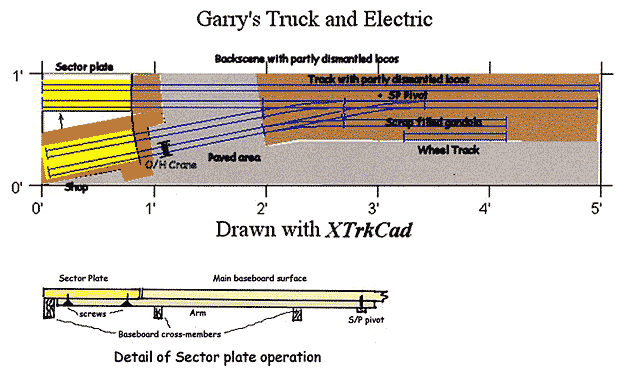 From “Shortliner” Jack Trollope, in the Scottish Highlands, comes this U.S. prototype layout for a 5×1 ft shelf. Garry’s Truck & Electric – a Division of Jaxilli Industries is an adaptation of my Car Repair Shop layout, originally designed for O scale but here adapted to HO. It’s a takeoff on the well-known Ohio firm, Larry’s Truck and Electric, which repairs and scraps old locomotives.
From “Shortliner” Jack Trollope, in the Scottish Highlands, comes this U.S. prototype layout for a 5×1 ft shelf. Garry’s Truck & Electric – a Division of Jaxilli Industries is an adaptation of my Car Repair Shop layout, originally designed for O scale but here adapted to HO. It’s a takeoff on the well-known Ohio firm, Larry’s Truck and Electric, which repairs and scraps old locomotives.
Jack comments, “My version is essentially the same as yours but with an extra track at the rear, and both the rear tracks are outside the building and hidden behind it at the left side. The rear track has old un-powered units and body shell parts in various states of disrepair, with the back-scene showing photos or paintings of more of the same fading into the distance.
“The main difference is that, because the angle of the building hides the interior from the viewers, it contains a sector plate on a long arm (see Detail) allowing locos to be moved through the non-existent rear wall and “fiddled”. The tracks are assumed to continue out of the rear of the building allowing them to be switched on the rear tracks, and the angled front hides the shenanigans going on inside. There might need to be an overpass at the right hand end, hiding the fact that the tracks go nowhere.”
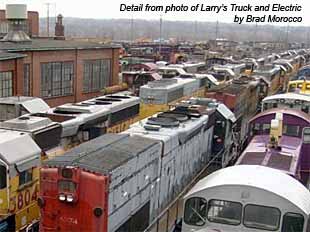 Larry’s Truck and Electric in McDonald, Ohio, is a fantastically cluttered and fascinating yard filled with hundreds of retired locomotives. Click on Brad Morocco’s picture at the right to see his full-sized photo of just one part of the yard (photo courtesy RailPictures.Net) .
Larry’s Truck and Electric in McDonald, Ohio, is a fantastically cluttered and fascinating yard filled with hundreds of retired locomotives. Click on Brad Morocco’s picture at the right to see his full-sized photo of just one part of the yard (photo courtesy RailPictures.Net) .
Detail abounds here, as Jack enumerates:
“Lots of scrap, a portable generator; loco-bodies, scrap bits and cabs, with a couple of the Walthers prime movers; lots of rust, dirt, gunge and grime; men in safety helmets and jackets; a couple of Knightwing Portakabins; a couple of old containers ‘converted’ to storage or offices.
“A Dapol overhead crane outside and a Walthers one inside add to the view blocks, and one(or two) of the LED arc welding ‘flashers’ inside with translucent “dirty” roof-panels and windows create “atmosphere”. Possibly a couple of yard lamps outside, or some amber LED’s for sodium portable lighting, fitted inside small rectangular covers, and lighting inside the shop.
“It’s one of those ‘working dioramas’ that can almost be added to forever!” {ED. NOTE: Jack is dealing in considerable understatement here — what a detail bonanza! Also, take a good look at his unique sector plate design … it looks to me like a very useful innovation for small layout planning!]
SCALE 1:87 (HOn30)
‘End of the Trail’ in the Old West
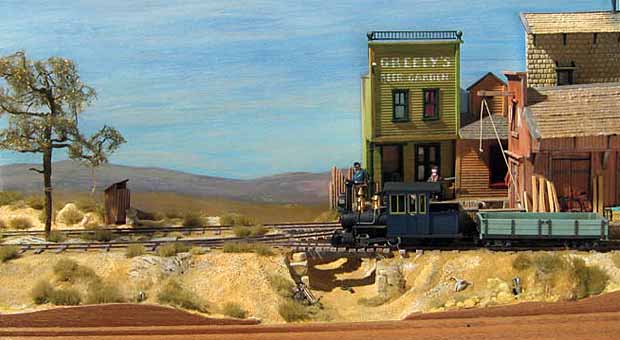
 You may be surprised to learn that this layout comes from the Loire region of France! François Fontana, from Saint Ettienne, offers the following footnotes about this extremely appealing shelf layout:
You may be surprised to learn that this layout comes from the Loire region of France! François Fontana, from Saint Ettienne, offers the following footnotes about this extremely appealing shelf layout:
“This is the Berland’s River End layout — an excursion into the far West ! I put into this layout all my mental pictures of the West: a corral as in the film ‘OK Corral’, the saloon — Greely’s beer garden — as in the Clint Eastwood film, an old cow head, a Mexican citizen asleep under his sombrero, a rope for a hanged man, a big rattlesnake; the sheriff is a left-handed man, the old timer sits in a chair with wheels, and there is even an old Gatling gun from the last Mexican revolution! To finish the scene I wanted stub points, a little wood trestle, big mountains in the bakdrops, and sandy countryside.
“The track is homemade with code 40 rails from Micro Engineering, stub turnouts are handmade. Rolling stock is from various builders like Joe Works, Sierra West, and Meridian. Little people are made from plasticine. On the right there is a fiddle yard — a traverser with three tracks. A little storage track is hidden in the corral. The layout is 40×15 cm (16×6 in) and the fiddle yard is 20×15 cm (8×6 in).”
[ED. NOTE: François’ wonderful Old West picture illustrates how much layout can be squeezed into a very small bookshelf using tiny scales like HOn30. ]
SCALE 1:120 (TT)
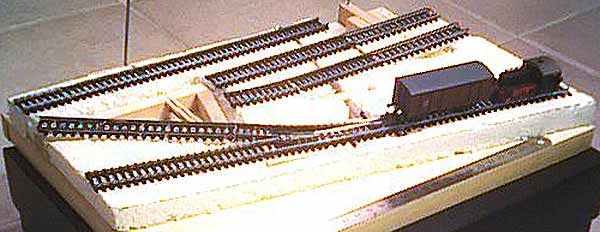 Alexander Lehmann, from Mannheim, Germany, discovered “shoebox” layouts in these pages and is building a TT scale version which will also easily fit on a bookshelf. As yet unnamed, the layout is 36×25 cm (14×10 in) and is built in TT scale (1:120), which allows considerable railroading in a very small area.
Alexander Lehmann, from Mannheim, Germany, discovered “shoebox” layouts in these pages and is building a TT scale version which will also easily fit on a bookshelf. As yet unnamed, the layout is 36×25 cm (14×10 in) and is built in TT scale (1:120), which allows considerable railroading in a very small area.
According to Alexander, “I plan a harbour scene with two unloading tracks in the harbour front. To run around the cars I plan a traverser an two tracks. One of them can also be used as an unloading track. The sector plate is even big enough to shunt the ‘Köf’-locomotive and one car. I think it will be interesting to shunt with two or three cars and the locomotive.”
Thus far, Alexander has built the trackwork, as well as the traverser and sector plate. He has begun running trains, and is delighted with the operations. We’ll try to bring you pictorial updates as construction progresses.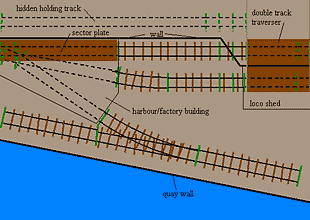
SCALE 1:160 (N)
N scale is a natural for small layouts, and shelf lines are an inevitable medium for it. My Rollaway Hills Railway shows how much N scale railroading can be packed into a space of only two square feet! The design is a 72×4 in. (180×10 cm) adaptation of the Starter Layout in the Micro Layout Design Gallery. It represents the small town terminus of a U.S. branch line.
There’s a small industrial spur line sneaking off to a wharf and providing a healthy traffic source between the ships’ cargoes from the wharf and the bustling team track along the waterfront. There’s a passenger station of sorts at the terminus, which could be served by a gas-electric or (in the U.K.) a DMU push-pull set.
I’ve suggested the simplest form of fiddle yard, which is a removable cassette that can be loaded with selected cars, reconnected, and the train hauled onto the layout proper — all very quickly done, so there’s no dearth of action at Rollaway Hills. I’m not sure what the industry at Rollaway Hills might be, but it’s a busy one, being served by virtually every train that arrives in town. And of course, it will require transferring its products by rail to the wharf for shipment ’round the world.
Car waybill operation is a natural for this little line, and it might even be able to tolerate timetable running, as there’s essentially no mainline length to contend with … and model switching moves take just about as much time as the real thing. A switch crew will be interrupted periodically by the arrival of the passenger consist, which can snarl even their best-laid plans as they scramble out of the way of the varnish – or head over to the wharf for lunch!
Most of the scenery is made as low-relief “profile” models, because track takes up a lot of the acreage. But the nature of the community — facing a waterfront (either river or ocean) — allows us to use convincing backdrops of buildings, warehouses, railway stations, brick walls (with lots of graffiti), and the like.
This line was designed as a non-competing contribution to the All Model Railroading N Scale Forum two-square-foot layout challenge . You might want to have a look at some of the excellent competition entries, which we hope to feature in these pages at some point.

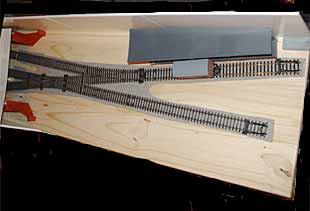
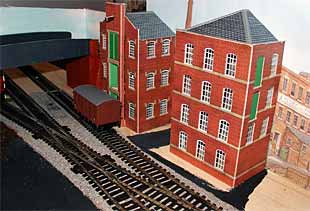
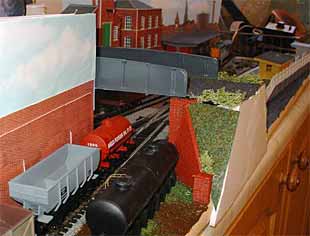
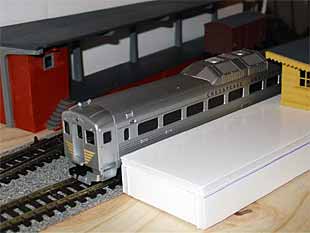
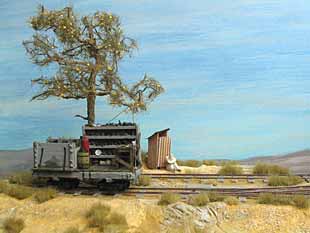
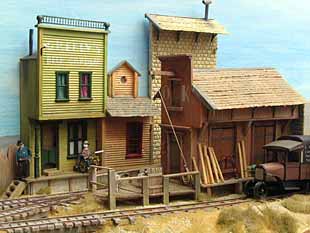
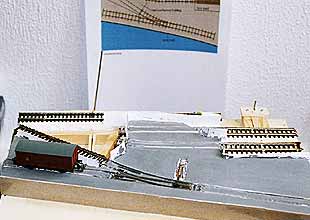

Leave a Reply